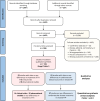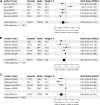Sex differences in treatment of familial hypercholesterolaemia: a meta-analysis
- PMID: 38976372
- PMCID: PMC11400737
- DOI: 10.1093/eurheartj/ehae417
Sex differences in treatment of familial hypercholesterolaemia: a meta-analysis
Abstract
Background and aims: Familial hypercholesterolaemia (FH) is a highly prevalent monogenic disorder characterized by elevated LDL cholesterol (LDL-C) levels and premature atherosclerotic cardiovascular disease. Sex disparities in diagnosis, lipid-lowering therapy, and achieved lipid levels have emerged worldwide, resulting in barriers to care in FH. A systematic review was performed to investigate sex-related disparities in treatment, response, and lipid target achievement in FH (PROSPERO, CRD42022353297).
Methods: MEDLINE, Embase, The Cochrane library, PubMed, Scopus, PsycInfo, and grey literature databases were searched from inception to 26 April 2023. Records were eligible if they described sex differences in the treatment of adults with FH.
Results: Of 4432 publications reviewed, 133 met our eligibility criteria. In 16 interventional clinical trials (eight randomized and eight non-randomized; 1840 participants, 49.4% females), there were no differences between males and females in response to fixed doses of lipid-lowering therapy, suggesting that sex was not a determinant of response. Meta-analysis of 25 real-world observational studies (129 441 participants, 53.4% females) found that females were less likely to be on lipid-lowering therapy compared with males (odds ratio .74, 95% confidence interval .66-.85). Importantly, females were less likely to reach an LDL-C < 2.5 mmol/L (odds ratio .85, 95% confidence interval .74-.97). Similarly, treated LDL-C levels were higher in females. Despite this, male sex was associated with a two-fold greater relative risk of major adverse cardiovascular events including myocardial infarction, atherosclerotic cardiovascular disease, and cardiovascular mortality.
Conclusions: Females with FH were less likely to be treated intensively and to reach guideline-recommended LDL-C targets. This sex bias represents a surmountable barrier to clinical care.
Keywords: Atherosclerotic cardiovascular disease; Familial hypercholesterolaemia; Females; Lipid-lowering treatment; Sex differences; Systematic review.
© The Author(s) 2024. Published by Oxford University Press on behalf of the European Society of Cardiology.
Figures








References
-
- Hu P, Dharmayat KI, Stevens CAT, Sharabiani MTA, Jones RS, Watts GF, et al. . Prevalence of familial hypercholesterolemia among the general population and patients with atherosclerotic cardiovascular disease: a systematic review and meta-analysis. Circulation 2020;141:1742–59. 10.1161/CIRCULATIONAHA.119.044795 - DOI - PubMed
-
- Nordestgaard BG, Chapman MJ, Humphries SE, Ginsberg HN, Masana L, Descamps OS, et al. . Familial hypercholesterolaemia is underdiagnosed and undertreated in the general population: guidance for clinicians to prevent coronary heart disease: consensus statement of the European Atherosclerosis Society. Eur Heart J 2013;34:3478–3490a. 10.1093/eurheartj/eht273 - DOI - PMC - PubMed
Publication types
MeSH terms
Substances
Grants and funding
LinkOut - more resources
Full Text Sources
Medical
Miscellaneous

